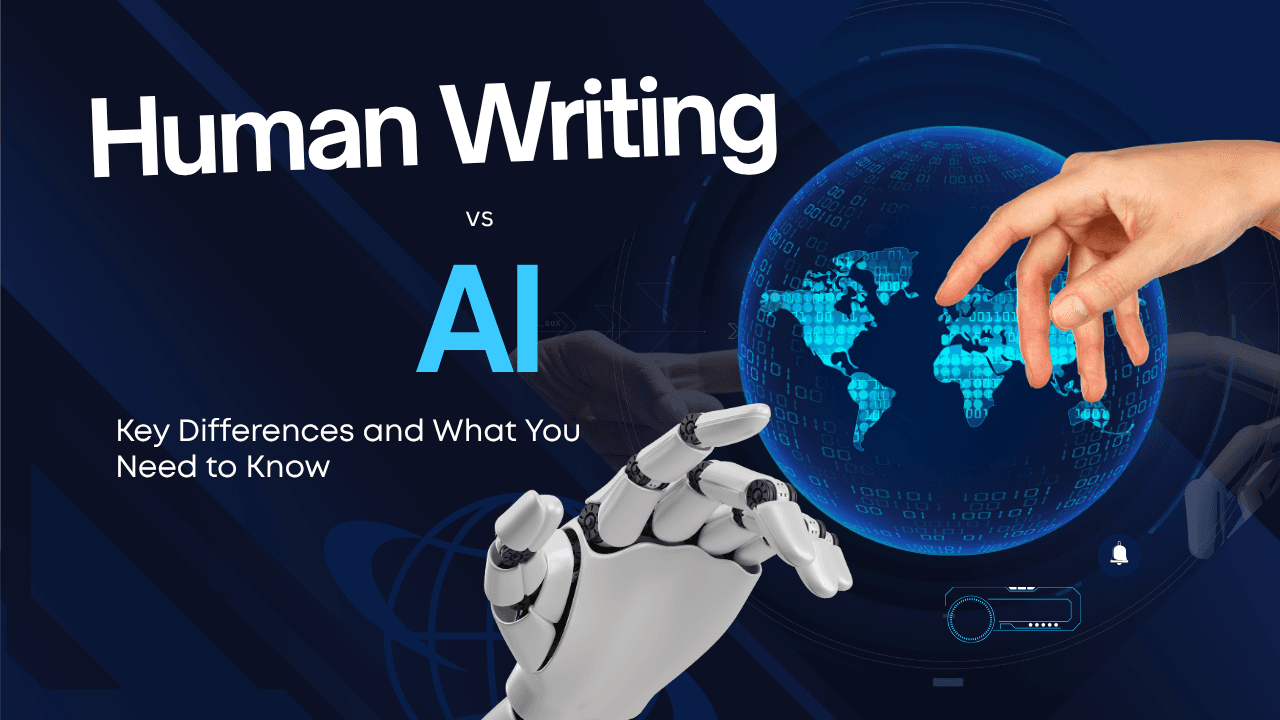In today's digital age, artificial intelligence (AI) has made significant strides in the field of writing. Tools powered by AI can generate everything from simple blog posts to detailed research papers with just a few clicks. However, despite these advancements, many are still left wondering whether AI-generated text can truly match human writing. While AI offers efficiency and consistency, human writing stands out for its creativity, emotional depth, and unique perspectives.
This blog post dives into the key differences between AI and human writing, exploring technical aspects like perplexity and burstiness, as well as non-technical elements such as emotional engagement and creativity. By the end of this post, you’ll have a deeper understanding of how AI and human writing compare, and how tools like Humanize AI Text can help bridge the gap between the two.
Understanding Perplexity and Burstiness in AI and Human Writing
Perplexity: Measuring Complexity in Writing
Perplexity is a metric that evaluates how well a language model predicts the next word in a sentence. For AI, a lower perplexity means that the model is more confident in predicting the next word based on the previous words in the sentence. Human writing, however, tends to have higher perplexity because humans introduce unpredictability, creativity, and complexity that AI models struggle to mimic.
- High Perplexity Example (Human-Written): "The sun, heavy with stories untold, dipped below the horizon as the city, alive with the pulse of a thousand hearts, whispered secrets in the dusk."
- Low Perplexity Example (AI-Generated): "The sun set behind the buildings, and the city became quieter."

Perplexity.ai vs humanizeaittext.ai
Human-written text often incorporates literary devices like metaphors, which contribute to its higher perplexity, while AI tends to produce more straightforward and predictable content.
Burstiness: The Rhythm of Writing
Burstiness refers to the variation in sentence length and structure. In human writing, you'll often see bursts of short, impactful sentences followed by longer, more complex ones. This variation adds rhythm and flow to the content, making it more engaging. AI-generated writing, on the other hand, tends to be more uniform, with sentences of similar length and structure.
- High Burstiness Example (Human-Written): "The alarm blared. Feet hit the floor. The tea kettle whistled. Steam billowed. Heart pounding. The world, awake."
- Low Burstiness Example (AI-Generated): "The morning was calm. I heard the kettle whistle, and I got out of bed."
Human writing creates a sense of unpredictability that draws readers in, while AI writing remains more predictable and structured.
Non-Technical Differences: Creativity, Emotion, and Engagement
Creativity and Originality in Human Writing
One of the most significant differences between AI and human writing is the creative aspect. Human writers draw from their own experiences, emotions, and unique perspectives, infusing their writing with creativity and originality. AI, while capable of generating content, relies heavily on pre-existing data and patterns, which can make its output feel repetitive or formulaic.
Human writers often produce content that is rich in metaphors, analogies, and personal anecdotes, making the writing more engaging and relatable. AI, on the other hand, struggles to generate fresh ideas or offer unique perspectives beyond what it has been trained on.
Example of Human Creativity:
"Life is like a river, constantly flowing, never the same. Each bend brings new challenges, new lessons, and new growth. We, like the river, must keep moving, always adapting, always learning."
Example of AI-Generated Text:
"Life involves many challenges. We must keep moving forward and adapt to new situations."
The first example showcases human creativity, with vivid imagery and a philosophical touch. The second, while clear, is more formulaic and lacks the emotional depth of the human-written piece.
Emotional Appeal: The Human Touch
Human writing excels in emotional appeal. It can express joy, sorrow, excitement, and other emotions, making it more relatable and engaging for readers. Humans use anecdotes, humor, and personal stories to connect with their audience on an emotional level.
AI-generated content, while accurate and informative, often lacks this emotional depth. It can provide facts, but it struggles to evoke feelings or create a sense of empathy with the reader.
- Human Writing Example: "I remember the first time I saw the ocean. The vastness, the power, the endless blue stretching to the horizon. I felt small, yet connected to something much larger than myself. It was a moment that changed me forever."
- AI Writing Example: "The ocean is vast and powerful. It stretches to the horizon, covering a large area."
The human example invites readers to feel the awe and wonder the writer experienced, while the AI example merely describes the scene without emotional engagement.
AI’s Strengths: Accuracy, Consistency, and Efficiency
Consistency and Accuracy in AI Writing
One area where AI excels is in producing consistent and accurate content. AI can process vast amounts of data and generate content that adheres to a particular style or structure. This makes it ideal for tasks like technical writing, data analysis, and SEO content, where accuracy and consistency are paramount.
AI-generated text is also free from personal biases or emotional influences, making it highly reliable for factual reporting and standardized content. However, AI can suffer from "hallucinations"—a term used when the model generates content that sounds plausible but is factually incorrect. This is one of the challenges of relying solely on AI-generated text without human oversight.
Human Writing: Creativity and Emotional Depth
While AI can churn out data-driven content with remarkable speed and accuracy, human writers bring creativity, emotional resonance, and originality to their work. This makes human writing essential for content that aims to connect deeply with readers, such as blogs, novels, and personal stories.
Humans can draw from their lived experiences, offering unique insights and perspectives that AI cannot replicate. This creativity and emotional depth are what make human writing indispensable for building meaningful connections with audiences.
AI Content Detection: Can AI Be Detectable?
AI content detection tools have become increasingly sophisticated in identifying machine-generated text. These tools analyze the patterns in the text, looking for telltale signs like uniform sentence structure, lack of emotional depth, and unnatural phrasing.
Human Writing vs AI Detection:
While AI can generate content that appears to be human-like, tools like Humanize AI Text can help bridge the gap by tweaking AI content to make it more natural. This ensures that AI-generated content can bypass detection tools while still maintaining its quality.

AI vs Human Writing
If you're concerned about AI content being flagged as machine-generated, using humanizing tools can help refine the writing and make it indistinguishable from authentic human-produced content.
How Can AI Tools Enhance Human Writing?
While AI has its limitations, it can also be a powerful tool for enhancing human writing. AI tools like Humanize AI Text can improve the quality of machine-generated content, making it sound more natural, engaging, and human-like.
Conclusion
AI and human writing each have their strengths and weaknesses. AI excels in consistency, accuracy, and speed, making it ideal for technical content and data-driven articles. However, it falls short in areas like creativity, emotional depth, and originality, where human writing truly shines.
By leveraging tools like Humanize AI Text, we can bridge the gap between AI's efficiency and human creativity, resulting in content that is both accurate and emotionally engaging. As AI continues to evolve, its collaboration with human writers will only become more seamless, offering endless possibilities for content creation.
Frequently Asked Questions About AI vs Human Writing
What is the main difference between AI and human writing?
AI writing is efficient and consistent but lacks emotional depth and creativity. Human writing brings creativity, emotional appeal, and originality.
Can AI-generated content pass as human writing?
With tools like Humanize AI Text, AI content can be refined to sound more human-like, making it harder to distinguish between the two.
Is AI writing good for SEO?
Yes, AI is great for creating SEO-friendly content. However, it lacks the creative flair needed to make the content engaging. Human writers can enhance AI content to make it both SEO-friendly and captivating.
What are the challenges of using AI for writing?
AI can struggle with originality, creativity, and emotional engagement. It can also produce factually incorrect content, requiring human oversight.
How can I make my AI content more engaging?
Using AI tools like Humanize AI Text can refine machine-generated content, making it ,sound more natural, creative, and emotionally engaging.


